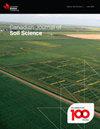Enhancement of the three-dimensional interfacial layer of a rocky desertification soil using a red mud-based fertilizer
IF 1.5
4区 农林科学
Q4 SOIL SCIENCE
引用次数: 0
Abstract
Abstract Red mud, a solid waste of alumina extraction from bauxite, was used as a compost carrier to prepare a geological fertilizer. It was amended at proportions of 0, 5%, 10%, 15% and 50% by weight (g/kg) to improve a rocky desertification soil (classified as lime soil) productivity. Through the simulation of different rain intensity (15, 50, and 90 mm/h) with three precipitation rates (1000, 2000, 3000 mm), soil chemical and physical properties, such as soil organic matter (SOM), total nitrogen (TN), ammonia nitrogen (AN), nitrate nitrogen (NN), total potassium (TK), available potassium (AK), total phosphorus (TP), available phosphorus (AP), bulk density and aggregates were tested and analyzed. In addition, a three-dimensional evaluation and analysis of the improvement attributed to the geological fertilizer was conducted. The results showed that the soil loss could be maintained in the range of 19%–72% under rainfall intensities. In addition, the reduction rate of soil clay content was less than 20%, and the lowest reduction rate of SOM, TN, TP and other nutrient was only 4% at the application rate of 5%–50%. The BD of the 0–20 cm top soil decreased progressively from 1.2 to 0.9 g/cm3, while the water-stable aggregate volume increased by 45%–76%. The red mud-based fertilizer enhanced the ability of the rocky desertification soil to resist rainfall erosion and infiltration in amended soil profiles. Considering the trends of nutrient losses and effects on the soil structure, the application rate of 15% by weight (g/kg) was best for improving the rocky desertification soil productivity.利用红泥基肥料增强石漠化土壤的三维界面层
以铝土矿提取氧化铝固体废弃物赤泥为堆肥载体,制备地质肥料。分别按0、5%、10%、15%和50%的重量(g/kg)对石漠化土壤(石灰土)进行改良,提高其生产力。通过模拟不同降雨强度(15、50和90mm/h)和3种降水速率(1000、2000、3000mm),测试和分析了土壤有机质(SOM)、全氮(TN)、氨氮(AN)、硝态氮(NN)、全钾(TK)、速效钾(AK)、全磷(TP)、速效磷(AP)、容重和团聚体等土壤理化性质。此外,还对地质肥料的改良作用进行了三维评价和分析。结果表明,在降雨强度下,土壤流失量可保持在19 ~ 72%的范围内。此外,在施用5-50%时,土壤粘粒含量的降低率小于20%,SOM、TN、TP等养分的最低降低率仅为4%。0 ~ 20 cm表层土的BD由1.18 g/cm3逐渐降低至0.86 g/cm3,而水稳性团聚体体积增加了45 ~ 76%。改良后的石漠化土壤对降雨侵蚀和入渗的抵抗能力增强。综合考虑土壤养分流失趋势和对土壤结构的影响,以15% (g/kg)的施用量提高石漠化土壤生产力效果最佳。
本文章由计算机程序翻译,如有差异,请以英文原文为准。
求助全文
约1分钟内获得全文
求助全文
来源期刊

Canadian Journal of Soil Science
农林科学-土壤科学
CiteScore
2.90
自引率
11.80%
发文量
73
审稿时长
6.0 months
期刊介绍:
The Canadian Journal of Soil Science is an international peer-reviewed journal published in cooperation with the Canadian Society of Soil Science. The journal publishes original research on the use, management, structure and development of soils and draws from the disciplines of soil science, agrometeorology, ecology, agricultural engineering, environmental science, hydrology, forestry, geology, geography and climatology. Research is published in a number of topic sections including: agrometeorology; ecology, biological processes and plant interactions; composition and chemical processes; physical processes and interfaces; genesis, landscape processes and relationships; contamination and environmental stewardship; and management for agricultural, forestry and urban uses.
 求助内容:
求助内容: 应助结果提醒方式:
应助结果提醒方式:


